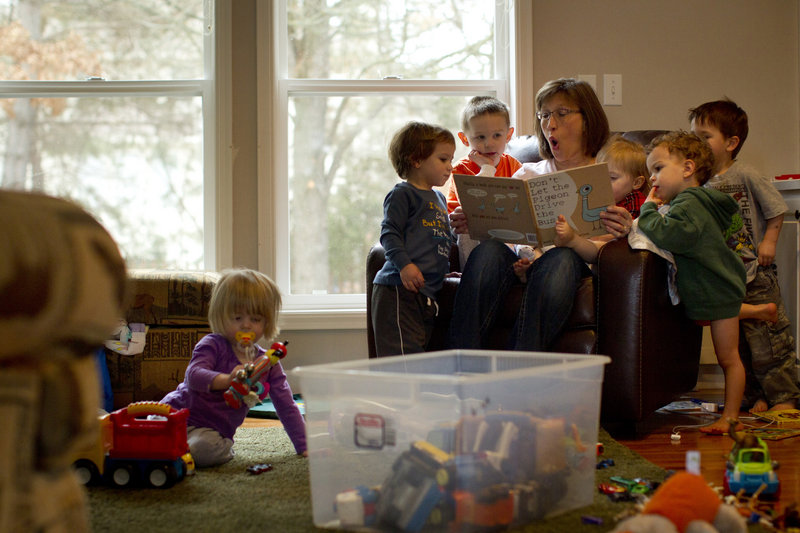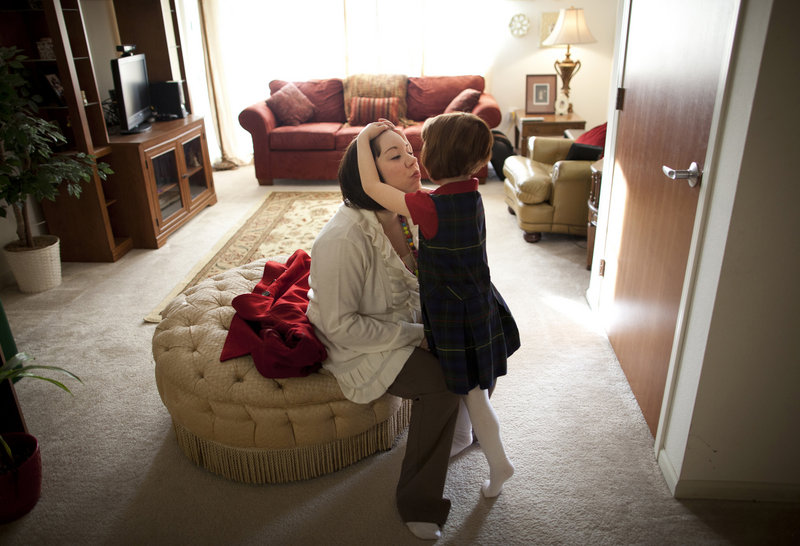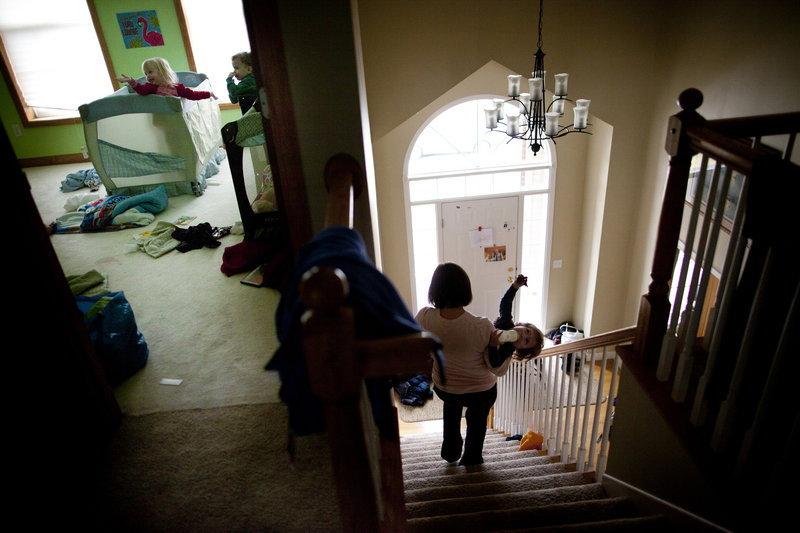MINNEAPOLIS – A business degree and a decade of negotiating information technology contracts didn’t prepare Denise Sjoberg for workdays changing diapers, comforting crying toddlers and negotiating nap times.
But then, she’s not the only middle-class American adapting in tough times.
Sjoberg, who holds an MBA, was laid off in 2009. When the 49-year-old mother of three teenagers couldn’t find a job in her profession, she opened a licensed day-care center out of her home in Eagan, Minn.
Today, she makes $13,000 less per year, thinks twice before going out to eat and won’t take a big vacation any time soon. “You don’t compare what you had with what you’re going to have next,” Sjoberg said.
Across the country, household incomes have been falling for a decade, a dip accelerated by the Great Recession and profoundly felt by the middle class. From 2007 to 2010, the median household yearly income nationwide fell from $52,823 to $49,445.
The recession upended a fundamental assumption of middle-class life — the belief that most working families can count on earning a little more than the year before.
“All of those rules you had about how the world operates, they’re all gone,” said Tom Gillaspy, Minnesota’s demographer.
The 8 million jobs lost to the recession cemented a decade of declining income. Roughly 60 percent of job losses fell disproportionately on mid-wage hourly positions, according to the National Employment Law Project.
As a result, wage growth has been slower the past two years than at any time over the past 30 years, the Economic Policy Institute says. Most economists do not expect a swift reversal, even as the economy shows signs of strengthening.
That leaves many middle-class Americans in the midst of a vast recalculation — about careers, lifestyles, homes and retirement. They must reassess what they value and how they define success. It means frugal living, postponing retirement and retraining if they want to restart their careers.
“They have to recalibrate what they can expect,” said Russell Price, an Ameriprise Financial economist.
Many in the middle class who never lost their jobs are still struggling with declining incomes.
Wendy and George Vyskocil of Otsego, Minn., managed to hold onto their jobs during the recession — she as a medical transcriptionist, he as a union heavy equipment operator. But they now make about $60,000 a year, a little more than half of what they once earned.
“My husband has only worked four months in each of the last two years,” said Wendy Vyskocil, who once made $45,000 a year but now makes $28,000 after pay cuts.
The couple are “mad, sad and frustrated,” as they have retooled their lifestyles to get by. They shop at bargain stores and do much of their own auto and home repairs. They trade do-it-yourself skills in a sort of barter system with family and friends.
If George Vyskocil doesn’t get work in the next two months, the couple will have to try to renegotiate their obligations. Even if their income returns to where it was, their spending habits will not.
“We won’t just live within our means,” Wendy Vyskocil said. “I want a financial cushion of at least six months in case this ever happens again.”
Such hard lessons are playing out across the country, as a broad range of middle-wage jobs disappeared during the recession, and the sluggish recovery hasn’t brought enough of them back. In fact, the highest rate of job growth has been among lower-income positions.
“People who lost their jobs during the downturn have gotten hit really hard,” said Heidi Shierholz, an economist with the Economic Policy Institute.
Many workers who were laid off haven’t fully recovered, even after being rehired, Shierholz said. When they got a new full-time job, the wage was 10.5 percent lower than their previous salary in 2010.
Tom Sparks, 56, was unemployed for only a few weeks during the recession, but at times he has worked three jobs to support his three daughters. During those stretches, a typical workday would start at 1:45 a.m., when he would distribute newspapers, followed by an 11-hour shift selling mattresses. Then he would deliver mattresses after hours for extra cash.
It still was not enough to replace roughly $15,000 a year in lost commissions because of the downturn. “A mattress is (a purchase) you can put on the back burner,” he noted.
At one point, Sparks says, he was close to bankruptcy but managed to downsize. He consolidated his credit card debt and bought a foreclosed townhouse. Now, as his commissions begin to rise, so do his spirits.
“People are buying mattresses again,” he said. “I think there’s light at the end of the tunnel.”
People in the middle class with college degrees are doing better than those with high school diplomas. But neither education nor previous career experience guarantees success in the today’s jobs market.
The numbers remain daunting. Nationwide, 6 million more people are unemployed than at the start of the recession — four jobless Americans for every available job.
John Curtis of Chanhassen, Minn., is one of them. Curtis worked for Wells Fargo and Bank of America in the reverse mortgages business. He earned more than $100,000 a year helping senior citizens stay in their houses and finance retirement with home equity.
Curtis, 61, knew the decline in real estate would eventually ruin the reverse mortgage business. So he quit in August 2010, just ahead of a bank restructuring that likely would have led to his layoff. He figured he could get a job in another part of the financial sector.
He was wrong.
Curtis has applied for more than 50 jobs in 18 months. He got one interview but was not hired. As he continues his search, Curtis is building a website to sell some travel writing and photography.
Meanwhile, his wife, Ann, postponed retiring as a school teacher. The couple cut back cable TV, canceled magazine subscriptions and stopped eating out. “I can’t remember the last time I bought clothes,” Curtis said.
By withdrawing $30,000 from his retirement savings, relying on Ann’s salary and drastically cutting back expenses, the Curtises managed to pay their bills last year.
“I always thought I was bulletproof,” Curtis said. “I never dreamed I’d be in this situation for such a long time.”
Demographic shifts could lead to better days for the middle class. Several economists believe that the pool of new workers will shrink in the next decade while job openings will increase as baby boomers retire. This should create more opportunities.
But that depends on a work force trained for the future.
“We think if we give kids two years of algebra we’re preparing them for college,” Gillaspy said. “We’re not even training them to be production workers.”
The next generation of middle-class jobs will require skills and education that many of today’s workers don’t have. Structural welders will be in demand; art historians, not as much. New math, science, technology and critical thinking programs are overdue, Gillaspy said.
While retraining and continuing education remain critical for many unemployed workers, it doesn’t guarantee success.
For 26 years, Jeannie Burke laid carpet and installed upholstery at the Bayliner boat plant in Pipestone, Minn. But the plant closed during the recession, and the work went overseas.
“It was scary,” said Burke, who was laid off Feb. 23, 2009, her 50th birthday. “I didn’t know about resumes or any of that.”
She followed the advice of almost every employment expert out there: retrain to start a new career.
Burke took advantage of a state program to go to Minnesota West Community College to become a medical assistant in the supposedly recession-proof health care industry. Despite the training, she still hasn’t seen a medical assistant’s job opening in her rural corner of the state.
Still, her education led to an opportunity. She used her new knowledge of medical terminology and treatment codes to get a job in the insurance department at Pipestone County Medical Center.
“I’m not making as much as I made at Bayliner,” Burke said. “It’s a struggle, but there’s nothing I can do. I’ll probably have to work ’til I’m dead.”
Joblessness landed hard on Kate-Madonna Hindes, a 30-year-old single mother from Chaska, Minn. She already had heavy debts, health care costs from a bout with cervical cancer. When she lost her job in risk management at Target Corp., she was forced to spend her life savings. Her theology degree wasn’t much help.
Then, Hindes went to work for the Minnesota Department of Employment and Economic Development helping others who had lost jobs. Finally, she rebooted her professional career as a social media consultant. She says the White House even invited her to apply for a new media post. She didn’t get it but vows to remain optimistic about her future.
“My idea of what I need to be middle class has changed completely,” Hindes said. “It’s just the basic necessities.”
Copy the Story Link
Send questions/comments to the editors.





Success. Please wait for the page to reload. If the page does not reload within 5 seconds, please refresh the page.
Enter your email and password to access comments.
Hi, to comment on stories you must . This profile is in addition to your subscription and website login.
Already have a commenting profile? .
Invalid username/password.
Please check your email to confirm and complete your registration.
Only subscribers are eligible to post comments. Please subscribe or login first for digital access. Here’s why.
Use the form below to reset your password. When you've submitted your account email, we will send an email with a reset code.